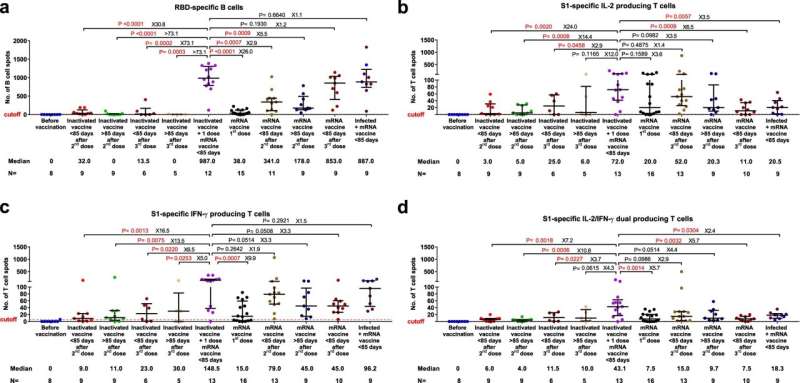mRNA booster vaccines may be a good investment in developing countries

Vaccines based on inactivated SARS-CoV-2 virus are commonly used in developing countries due to their low cost. New research from Karolinska Institutet in Sweden shows that a booster shot of mRNA vaccine to individuals who have received two doses of inactivated vaccine offers the same level of protection against COVID-19 as three doses of mRNA vaccine. The findings are published in the journal Nature Communications.
"Our results indicate that one booster shot of an mRNA vaccine, as a complement to the cheaper but less effective inactivated vaccines, is sufficient to achieve the 'gold-standard' immune response measured after three doses of mRNA vaccine," says Qiang Pan Hammarström, professor at the Department of Biosciences and Nutrition, Karolinska Institutet, who led the study. "That would likely be a good investment even in resource-poor countries to protect against severe COVID-19."
The study included 175 healthy volunteers with different vaccination histories. The researchers investigated the presence of antibodies and memory B and T cell responses against SARS-CoV-2 after vaccination and booster shots with an inactivated vaccine (Sinovac/Sinopharm), mRNA vaccine (Pfizer-BioNTech/Moderna), or a combination of both.
The results showed that a booster shot of an mRNA vaccine to individuals who had received two doses of inactivated vaccine strongly augmented the levels of neutralizing antibodies and memory B and T cells directed against SARS-CoV-2 variants of concern, including omicron. The levels were markedly higher than that of people receiving three doses of inactivated vaccine, and similar to that in individuals receiving three doses of mRNA vaccine or a boost of mRNA vaccine after natural infection.
May benefit billions of people
"Given that almost half of the COVID-19 vaccine doses distributed worldwide are inactivated vaccines, an improved mRNA booster strategy may benefit billions of people in our fight against emerging variants of concern," says Qiang Pan Hammarström. "A more widespread use of mRNA booster shots may also help China to overcome their current lockdowns."
A limitation of the study is the relatively low number of participants; only 16 individuals received vaccination with two doses of inactivated vaccine followed by an mRNA vaccine boost. Moreover, the median age of the study participants was 36 years of age, which is younger than the average global population. Hence, the results need to be confirmed in large-scale longitudinal studies that include different age groups.
Emerging omicron subvariants
The researchers will now continue to study the effect of the heterologous vaccination strategy on emerging variants of the SARS-CoV-2 virus.
"We will for the first time evaluate if this vaccination strategy can neutralize the two emerging omicron subvariants BA.4 and BA.5, underlying the new wave of COVID-19 in South Africa," says Qiang Pan Hammarström.
More information: Fanglei Zuo et al, Heterologous immunization with inactivated vaccine followed by mRNA-booster elicits strong immunity against SARS-CoV-2 Omicron variant, Nature Communications (2022). DOI: 10.1038/s41467-022-30340-5





















